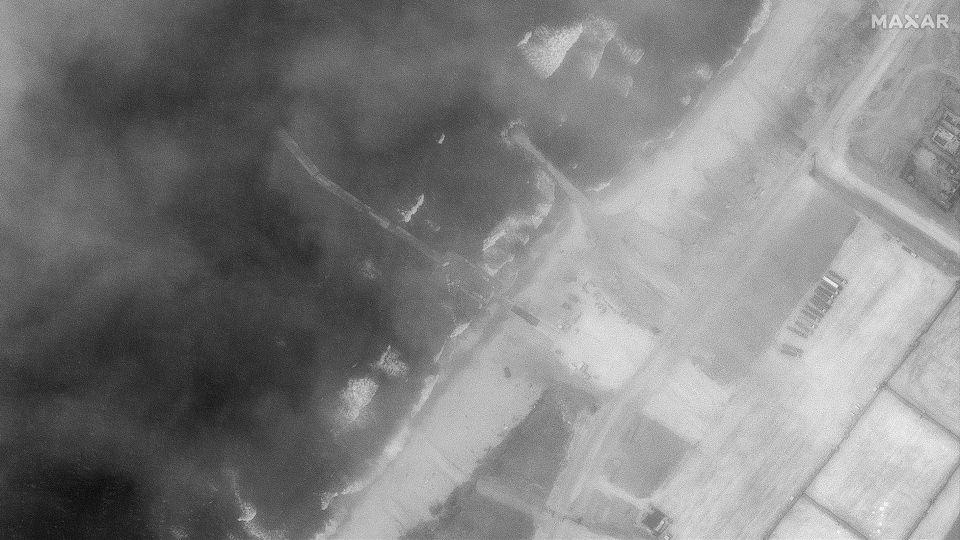US military’s Gaza pier has been repaired and reattached to beach

The US military’s temporary pier off the coast of Gaza was repaired and reattached to the beach on Friday morning, after breaking apart and sustaining damage in heavy seas last week, the deputy commander of US Central Command said on Friday.
“I’m very pleased to announce that earlier this morning, in Gaza, US forces successfully attached the temporary pier to the Gaza beach. Israeli Defense Force engineers provided all the necessary support to ensure the safe emplacement of the pier to the beach,” Vice Adm. Brad Cooper told reporters on Friday. “The policy of no US boots on the ground does remain in effect. We expect to resume delivery of humanitarian assistance from the sea in the coming days.”
Earlier on Friday, a US defense official said the pier, which was constructed by the US military to transport aid into Gaza, is expected to resume operations as soon as Friday with aid distribution resuming within the next day assuming all goes to plan.
“We anticipate that our goal will be to deliver 500,000 pounds over the beach initially and then ramp that up soon thereafter,” Cooper added.
A USAID spokesperson said Friday that the agency “remains in close contact with our colleagues from across the US government and humanitarian partners on the ground to ensure that aid can safely and effectively resume movement, which we expect in the coming days.”
The pier broke apart and sustained damage in heavy seas last week in a major blow to the American-led effort to create a maritime corridor for humanitarian supplies into the war-torn enclave.
The pier is the result of months of work by US officials trying to come up with a way to get aid into Gaza in addition to dropping it out of planes or trucking it through border checkpoints Even though it was operational for only about a week, the pier helped deliver some 1,000 metric tons of aid into Gaza before breaking apart.
The temporary pier, called the Joint Logistics Over the Shore (JLOTS), requires very good sea conditions to operate. It was anticipated to cost roughly $320 million and had only begun operating on May 17; officials have since said the cost is now closer to $230 million.
Cooper emphasized Friday that the damage to the pier stemmed “solely from unanticipated weather,” and that the military will continue to look at the weather closely going forward.
The JLOTS system consists of two parts: the floating pier where shipments will be offloaded and the causeway to transfer the shipments to the distribution point in Gaza.
The damage last week came after significant obstacles on distribution routes including Hamas drones and looting that delayed the deliveries. As a result, the US military had to help USAID come up with alternative, safer routes for trucks leaving the marshaling area on the beach near the pier and traveling to the warehouses.
Before then, the US had faced a number of challenges with the pier, including planning around Israel’s operations in Rafah; establishing who would transport the aid from the pier into Gaza; and logistical challenges such as sea and weather conditions.
The pier’s construction came as the humanitarian situation in Gaza deteriorates and the death toll from Israel’s bombardment climbs. In Gaza, the entire population has faced food insecurity.
The US has made a number of air drops of humanitarian aid into Gaza in partnership with the Royal Jordanian Air Force, though they were suspended in recent weeks due to military operations in the north of Gaza, Cooper said Friday. Air drops are expected to resume “in the coming days,” he said.
The USAID spokesperson said the maritime corridor is “just one of several entry points for life-saving aid arriving into Gaza, including critical land crossings.”
“We continue to push for all entry points into Gaza to remain predictably functional at maximum capacity, and that internal access be improved so that aid can reach people in desperate need,” the spokesperson said.
Along with food, Chris Mewett, the deputy assistant secretary of defense for global partnerships, told reporters Friday that there are other forms of aid being delivered over the pier.
“I think everyone recognizes that food is just one component — shelter, medical care, etc.,” Mewett said.
US officials previously told CNN the US military is likely to operate the pier for at least three months, but the ultimate goal is to turn it into a full-time commercial operation that can be used by other countries and non-governmental organizations.
This story has been updated with additional reporting.
CNN’s Shania Shelton, Jennifer Hansler, Oren Liebermann, Alex Marquardt, Haley Britzky, Kylie Atwood, Michael Conte and Helen Regan contributed to this report.
For more CNN news and newsletters create an account at CNN.com


